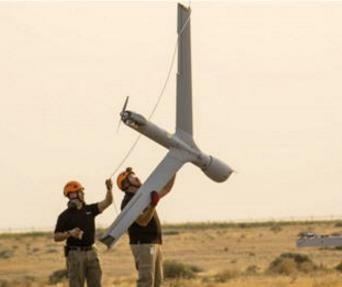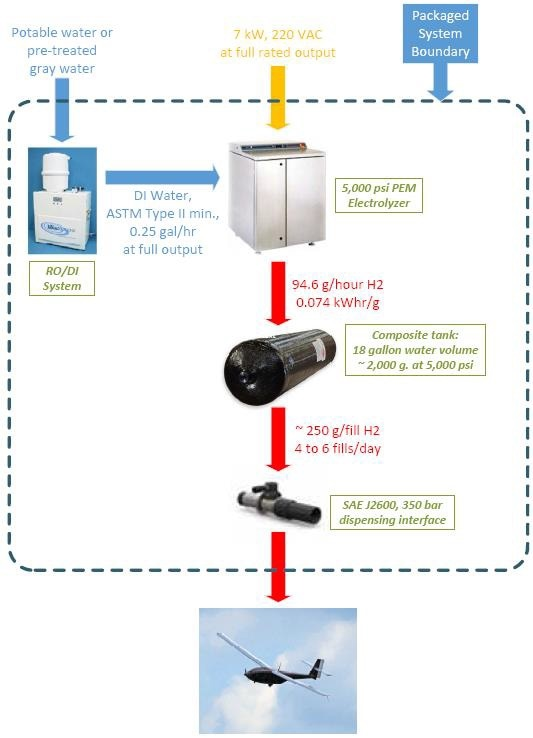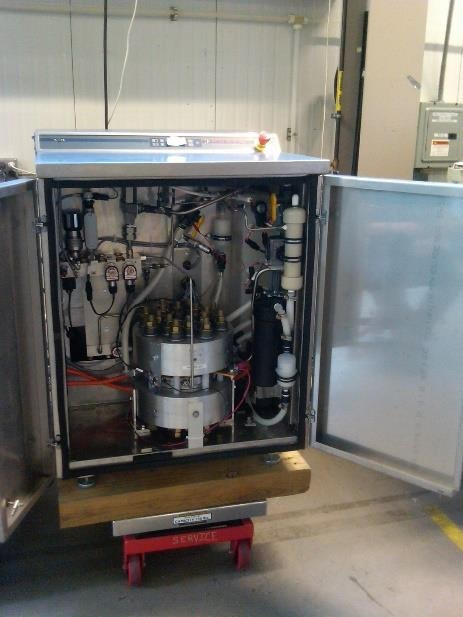Fuel cell systems in unmanned aerial vehicles (UAVs) were first used within military applications, but their viability in terms of range, durability and reliability have quickly opened doors to a diverse range of civilian and commercial applications as well.
A key challenge when using UAVs however, is their requirement for hydrogen fuel, especially when operating in remote locations. A proven solution to this issue is the production of hydrogen on-site, using electrolysis to produce this from water.
Utilizing a combination of a PEM fuel cell propulsion module from Protonex and high-pressure PEM electrolysis from Nel Hydrogen allows for a full, hydrogen fuelled solution that can easily accommodate the adoption of ready access to hydrogen, even at the most remote sites.
Hydrogen Fuel Cell Power for Unmanned Aerial Vehicles
Versatile and innovative, UAVs are being increasingly used for applications involving monitoring and surveying. It is expected that in the not-too-distant future, UAVs will perform a range of other roles including the delivery of packages or the provision of wireless internet access.
As interest in these possibilities and applications continues to grow, so does the demand for alternative sources of power which are able to provide better range, endurance and operational flexibility.

Hydrogen fuel cells offer an appealing solution to such challenges. These were first used in military UAVs, and these fuel cell systems have since been proven to provide good quality, durability, range and reliability.
Fuel cell-powered systems such as these are able to provide distinctive value for specific UAV applications, particularly due to their reliability over that of small internal combustion engines. They also offer benefits such as low maintenance requirements and improved safety, as well as operating for longer than their battery counterparts. In fact, these fuel cells are also able to show comparable benefits in terms of zero emissions and a low thermal noise signature.
High purity hydrogen provides the fuel for UAVs that are powered by proton exchange membrane (PEM) fuel cells. Thankfully, hydrogen is very easy to source commercially, with the U.S. hydrogen industry currently producing around 20 million metric tons of hydrogen every year.
The majority of the hydrogen produced is utilized with industrial applications like food processing, heat treating or the refining of petroleum. As well as commercial hydrogen supply, hydrogen refueling infrastructure is beginning to develop, mainly to support initial fleets and retail sales of transit buses and fuel cell passenger vehicles.
In California, hydrogen station roll-out has been adapted to the way that the majority of people drive and refuel – groups of stations in core commuting corridors as well as “connector” locations that allow for travel throughout the state. By 2020 it is anticipated that over 100 stations will be in place in California with another, wider network in development within the northeast of the country.
Plug Power has constructed 45 hydrogen stations to support over 14,000 fuel cell powered lift trucks which are operating at distribution centers and warehouses across the U.S. These stations distribute between 200 and 300 kilograms of hydrogen every day.
While this infrastructure is continually developing and expanding, it may not be able to accommodate fuel cell applications deployed in very remote sites. For example, UAVs are very often used to investigate natural disasters, or within military forward operating bases and large forest and agricultural plots. These are all areas where affordable, reliable access to hydrogen fuel can be especially challenging.
In situations like these, the most ideal solution is the production of small quantities of hydrogen on-site. This provides a means of bridging the gaps in hydrogen infrastructure, and this hydrogen can be generated on-site from a range of sources including liquid or natural gas hydrocarbon fuels, from water (via electrolysis) or from hydrogen carriers like sodium borohydride.
The best production process for a given application is very much dictated by the availability of feedstocks, and each of the production methods mentioned above has different cost and environmental implications. Moving forward, this article will specifically look at the production of hydrogen from water using electrolysis, and how this can be used as a means of fueling UAVs working in remote locations.
Enabling Low Cost and Reliable Hydrogen Production at Remote Sites
Production of hydrogen via water electrolysis is a well proven method that has been used within industrial applications for over 125 years. Additionally, electrolysis provides a promising option for the production of hydrogen using renewable resources in remote locations. It is relatively simple to produce hydrogen by using electricity to split water into its component parts of hydrogen and oxygen using a specialized device called an electrolyzer.
Electrolzyers are highly scalable and they are available commercially in compact, appliance-size equipment which is ideal for distributed hydrogen production. Platform developers of UAVs are very keen on the inclusion of “deployable” fueling capability and within both military and commercial applications, so a solution is needed which can be established at a location with ease, without the need for complex infrastructure and with the capability of being relocated quickly and easily.

Figure 1. Electrolysis is the splitting of water to produce hydrogen and oxygen gas.
In particular, small UAVs are designed to be deployable, and are specifically developed to offer a fast response coupled with mobility and speed. In cases where the fuel source must be able to move along with the user, an electrolyzer system which can accommodate these specific needs around mobility, environmental considers, available power and shock and vibe is imperative.
Being able to interface with renewable power sources and make use of reclaimed water may also be central considerations in a deployable system’s design. The U.S. Department of Energy (DOE) has tracked data which shows that electrolyzers are the most reliable piece of major equipment at hydrogen fuel stations.
PEM electrolyzers offer a combination of reliability and low maintenance requirements. This is especially the case when hydrogen generation systems can remove the need for a mechanical compressor, as this can provide improved reliability for smaller volume applications. Instead, a high-pressure electrolyzer can be used to produce high purity hydrogen at fueling pressure.
Deployable Refueling Concept
The concept for a deployable refueling system is an adaptation of an existing, compact electrolyzer system that has historically been used for launching weather balloons in remote locations. Here, electrolyzers are positioned within existing infrastructure to accommodate their water and power needs, so the hydrogen refueling station is part of the ground control system of an average UAV platform which is Group 2 (21-55 lbs) or bigger. In this case, power would be provided by an existing generator system already running the ground control, or alternatively via a renewable energy source or vehicle auxiliary power unit (APU).

Figure 2. Diagram of system components.
The inclusion of an integrated water purification system and existing reverse osmosis and de-ionization technology would mean that pre-treated gray water or potable water could be used. In this case, hydrogen produced by the electrolyzer would then the buffered in a composite tank before being dispensed to the UAV tank via a nozzle and connector.
Refueling of the onboard hydrogen tank should take less than 15 minutes, comfortably falling within the typical turn time window for the majority of existing UAVs in the Group 2 class.
The pressure of the electrolyzer system is a concern, and there are currently two means of addressing this. Commercially available electrolyzers generally operate below 500 psi, needing a mechanical compressor to increase the pressure and fill the hydrogen storage tank on the UAV. This design offers the flexibility to fill tanks over 5,000 psi, meaning that flight duration can be extended.
Alternatively, a design is currently in development which uses an electrolyzer stack to produce hydrogen directly at a pressure of 5,000 psi. This design could allow systems to be more reliable and efficient, as well as being less expensive due to the lower part count.
The image below highlights this approach to the system design. The high pressure electrolyzer can be fitted with a smaller single-stage boost compressor, allowing it to accommodate higher filling pressures and therefore enabling extended mission durations.

Figure 3. 5,000 psi Electrolyzer System.
Deployable refueling concepts such as this one offer a cost-effective solution to the challenge of ensuring readily available hydrogen fuel. On-site production allows for extended-range fuel cell powered UAVs to be used effectively, while removing the need for complex fuel supply logistics. Installing the electrolyzer is a simple process, and it can be connected to existing water supplies and power generators with ease.
Beyond Unmanned Aerial Vehicles
On-site hydrogen production can also benefit a range of other applications, such as vehicles which are co-located with a fuel cell-powered UAV. This is especially useful for military users; and idling or silent watch applications usually mean that the vehicle must operate without the main engine, all the while maintaining operation of communication and monitoring systems.
Within applications such as these, a dedicated power supply allows acoustic and infrared signatures to be reduced or even eliminated – something that is critical for mission effectiveness. Currently, battery systems are unable to accommodate the desired silent watch mission duration, but a hydrogen fuel cell could provide this capability so long as the hydrogen storage is an appropriate size.
An APU can provide a secondary power generator, and by using a silent hydrogen fuel cell APU it is possible to provide an alternate power source for some vehicle loads, thus reducing the need to rely on the vehicle’s primary power source. Systems such as these are already being trialed by the U.S. military, and United States Special Operations have been using Protonex’s M-300 Fuel Cells to allow for silent watch on both small wheeled vehicles and river craft.
Furthermore, the U.S. Army Tank Automotive Research, Development and Engineering Center (TARDEC) has already collaborated with General Motors to develop a mission-ready Chevrolet Colorado ZH2 Fuel Cell Vehicle that will use fuel cell power for both primary propulsion and silent watch.
TARDEC’s director Paul Rogers said, “Fuel cells have the potential to expand the capabilities of Army vehicles significantly through quiet operation, exportable power and solid torque performance, all advances that drove us to investigate this technology further.” The military field trials for these particular fuel cell applications will be happening in remote areas, so will need an available supply of high purity hydrogen.
These types of applications would require a fueling strategy to be developed that could support a portfolio of fuel cell-powered applications co-located in the field. This would allow costs to be optimized while allowing for synergy within the applications and infrastructure.
As electrolyzers have already been used to launch weather balloons in highly remote parts of the world, the U.S. Army have also tested Nel Hydrogen's equipment for launching tactical aerostats at similarly remote sites.
Additionally, the U.S. Government buys electrolyzers from Proton OnSite in order to provide hydrogen for lifting gas at meteorological stations in some of the world’s most remote locations such as Antarctica.
Conclusion
Often, applications for fuel cell-powered UAVs will need launch sites in dangerous or remote areas where the resupply of hydrogen (or indeed other fuel types) would be especially challenging, so, while the performance of fuel cells on UAVs is well established and documented, it is the fueling solution which is the primary barrier to deployment.
Using a combination of a PEM fuel cell propulsion module developed by Protonex and a high-pressure PEM electrolysis system from Nel Hydrogen offers a complete hydrogen-fueled solution which can overcome this barrier.

This information has been sourced, reviewed and adapted from materials provided by Nel Hydrogen.
For more information on this source, please visit Nel Hydrogen.